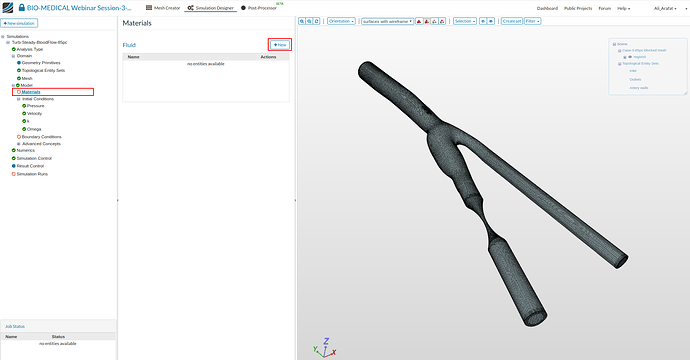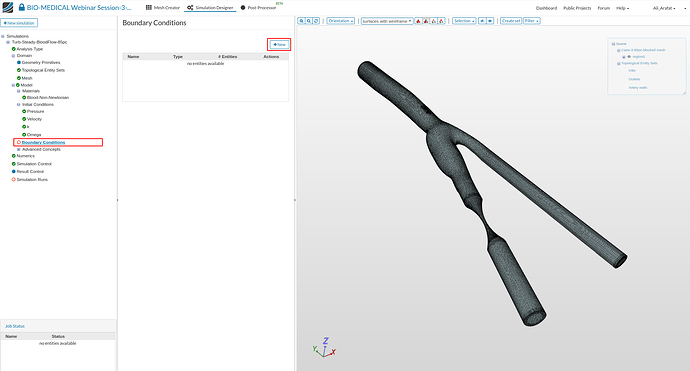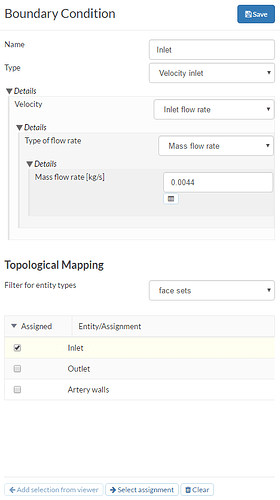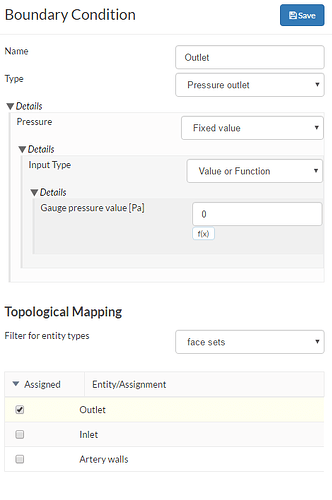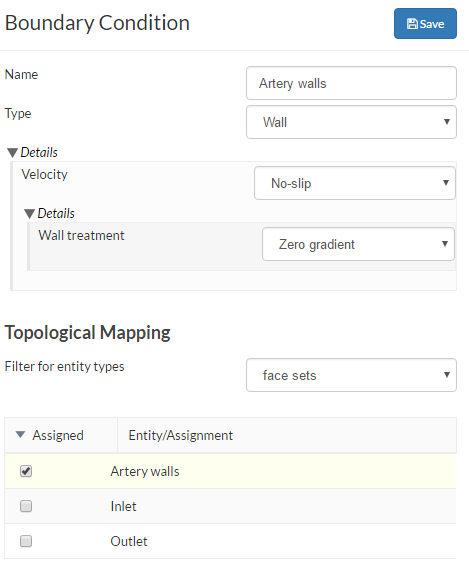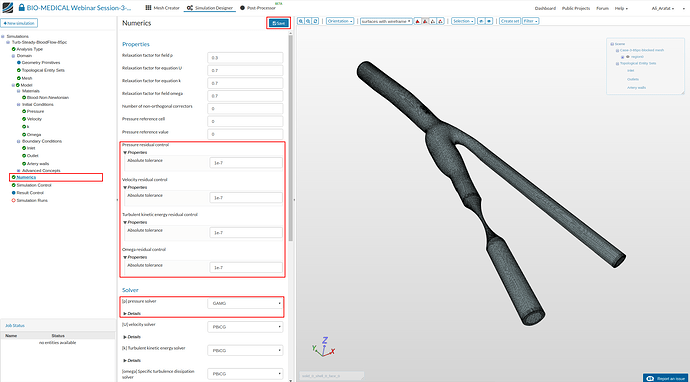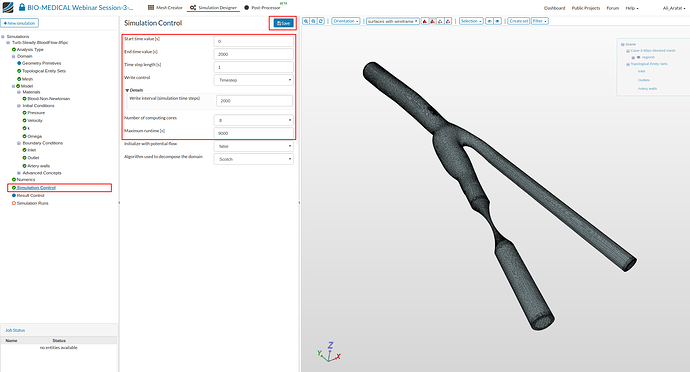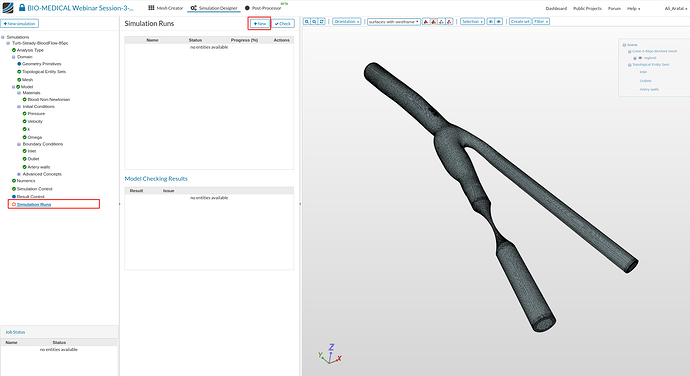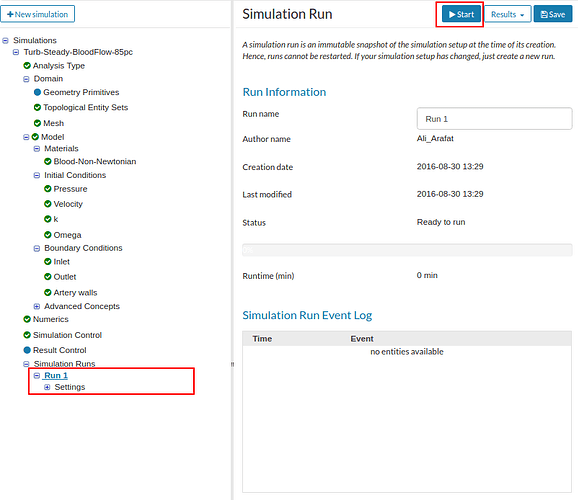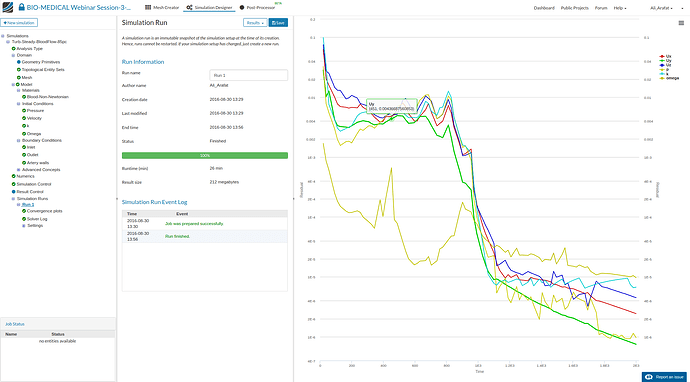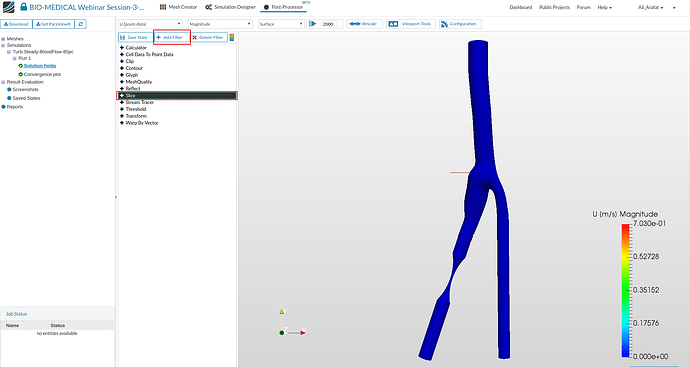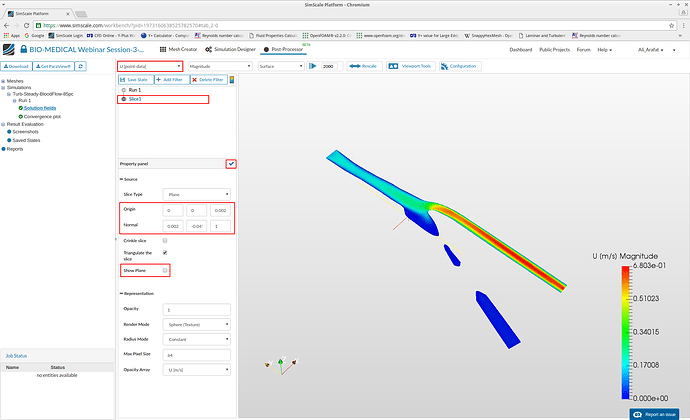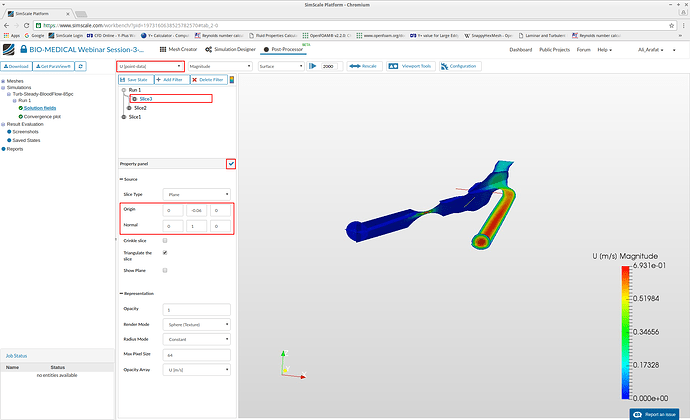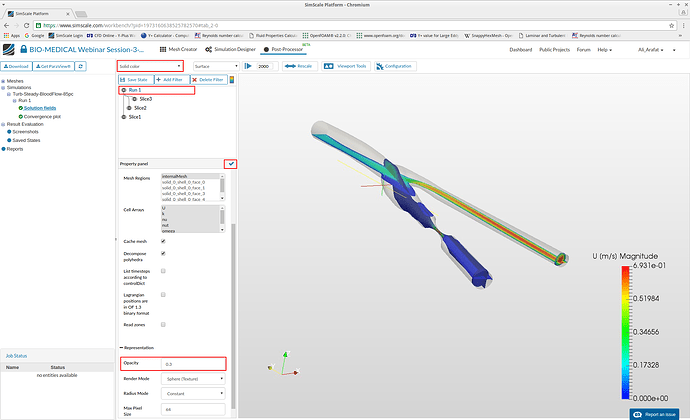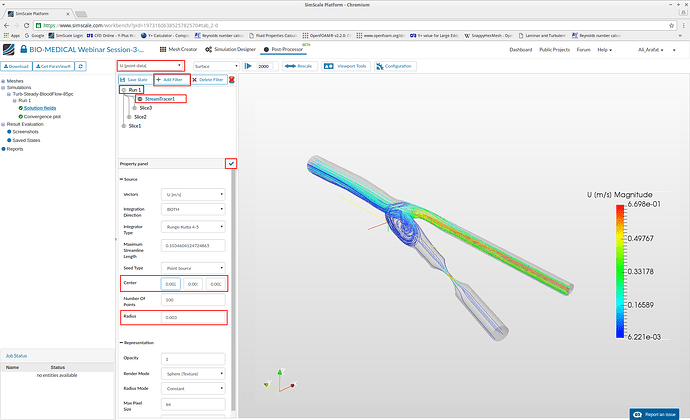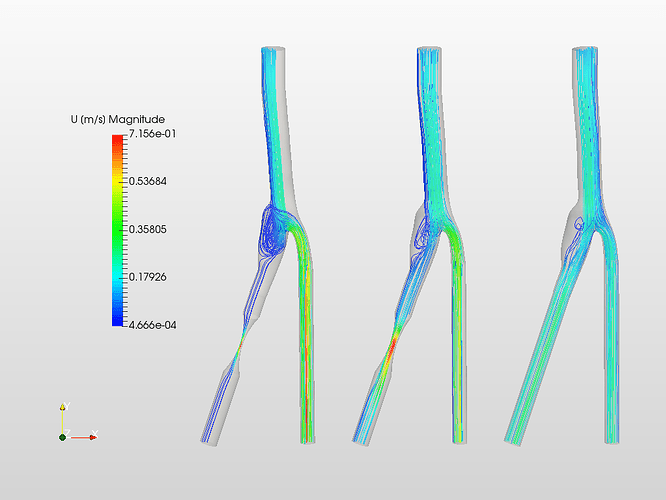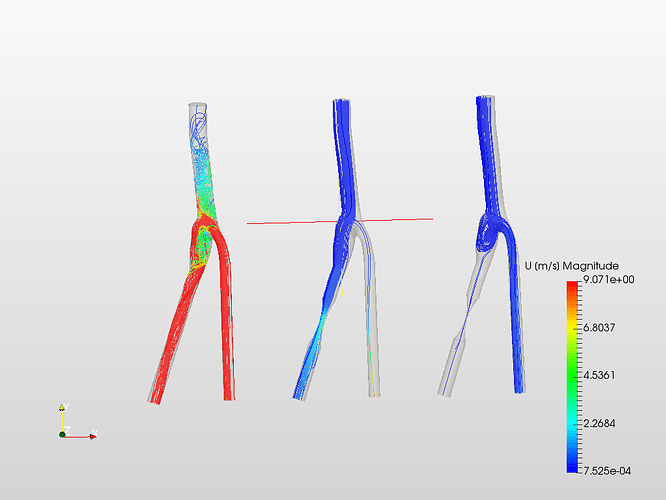Recording
Introduction
In this exercise, we will focus on simulating the flow of blood as a non-newtonian fluid through a Carotid Artery Bifurcation. The simulations are performed for 3 cases - the first, with a healthy blood vessel with no calcification or blockage; the second, through a moderately calcified blood vessel and the third, through a severely calcified or occluded blood vessel. The results will show the differences in pressure, velocity profile, and the outlet flow through the 2 branches.
The image below shows an overview of the 3 different cases:
This tutorial presents a step by step approach for simulating the third case with 85% occlusion of the Artery. The first 2 cases can then be done by duplicating the setups and following similar steps.
To start this exercise, please import the project into your workspace by clicking on the link below:
Mesh Generation
In the Mesh Creator tab, click on the geometry Case -3-85-pc-blocked
Then, click on the New Mesh button in the options panel.
Select the mesh Type Hex-dominant parametric. Then specify the following parameters:
- Number of cells in X-direction: 45
- Number of cells in Y-direction: 150
- Number of cells in Z-direction: 20
- Number of computing cores: 16
Click Save to preserve the mesh settings
After saving the Navigator is expanded with 2 new entries, called Background Mesh Box and Material Point which must be defined.
The Background Mesh Box defines the reference bounds of the base mesh. Enter the values as shown or use the default values:
- Min X= -0.019
- Min Y= -0.065
- Min Z= -0.004
- Max X= 0.013
- Max Y= 0.0415
- Max Z= 0.01
Click Save to preserve the mesh settings
The Material Point specifies the region that will be meshed. So in this case the point must be inside the body.
Enter the values:
- Center X= 0.0025
- Center Y= 0.001
- Center Z= 0.0025
Click Save to preserve the mesh settings
We will create a new geometric entity that will be later used for refinement of the narrow blocked region.
To create a New entity, click on Geometry Primitives and then the +New button on top to select a Cylinder entity.
Enter the values as shown:
- Reference Point (x): -0.01
- Reference Point (y): -0.043
- Reference Point (z): 0
- Axis (x): 0.0055
- Axis (y): 0.016
- Axis (z): 0
- Radius: 0.003
Click Save to preserve the mesh settings
We will now add the necessary mesh refinements for the previously created geometry sets and the geometry primitives.
Click on Mesh Refinements and click +New button to add a refinement.
Ref-surface
This refinement will be used to refine the surfaces for the complete solid geometry. Select the settings as follows:
- Name: Ref-surface
- Type : Surface refinement
- Level Min : 2
- Level Max : 2
- Assigned entity Type: Volume
- Entity: solid_0
Click Save to preserve the mesh settings
To create another refinement, hover your mouse over Mesh refinements and right-click to select Add mesh refinement.
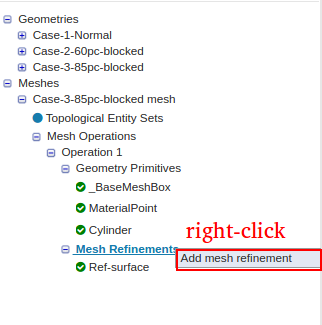
Ref-layer
The layer refinement is important to capture the behavior near the wall. This will create layer cells following the surface curvature near the walls.
Add a new Mesh Refinement, and choose:
- Type : Inflate boundary layer
- Change Number of layers: 3
- Keep the rest to default
Under the selection box, select the surfaces:
- shell_0_face_0
- shell_0_face_2
- shell_0_face_3
Click Save
Ref-edges
The feature refinement will refine near edges. This is important to capture sharp corners.
Add a New Mesh Refinement, and choose Type as Feature Refinement
Give a Distance of 0.0005 and a Level of 3.
Ref-volume-region
These regional refinements will refine the volume mesh. The first is for the entire inner region
Create a new Mesh Refinement enter the settings as follows:
- Name: Reg-volume
- Type : Region refinement
- Mode : Inside
- Distance : 1
- Level : 1
- Under Refined regions box select: solid_0
Then click Save
Ref-blocked-region
The next region is for the narrow blocked area. So create another ‘Mesh Refinement’ and enter the settings as follows:
- Name: Reg-blocked
- Type : Region refinement
- Mode : Inside
- Distance : 1
- Level : 3
- Under Assigned Geometry Primitive box select: Cylinder
Then click Save
Now click back on the main mesh Operation 1, scroll down in the settings panel to Mesh Quality controls and change the 3 parameters as shown and Save:
- Max non-orthogonality angle [°]: 65
- Max concaveness [°]: 70
- Min cell volume [m³]: 1e-18
- Note: This is important to get a good quality mesh.
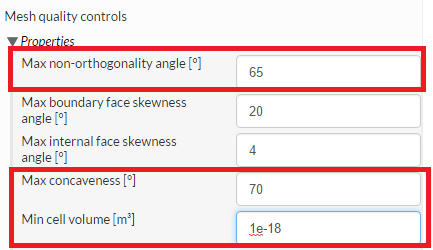
The mesh settings are all prepared, so click the Start button to begin the mesh generation process. This will take about 5 minutes.
Once the process is finished, the mesh is automatically loaded in the viewer.
Additional Meshes
Rather than creating meshes for Case 1 and Case 2 from scratch, it is faster to duplicate the mesh you’ve just created and then change the Base Geometry. To duplicate the mesh, just click on the Case-3-85pc-blocked mesh, then right-click and select Duplicate
Then click on the duplicated mesh, rename the mesh to Case-2-60pc-blocked mesh, change the Base Geometry to Case-2-60pc-blocked and click Save. (click yes on the confirmation/warning message)
Then you will have to Re-assign the corresponding Refinement entities as before.
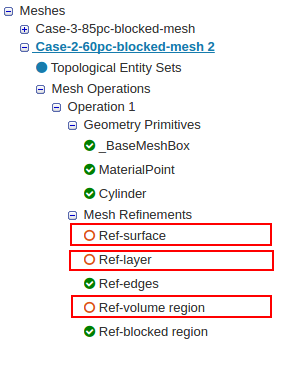
Once done go to Operation 1. Click Save and Start to generate the 2nd mesh.
Use the same methodology to create the mesh for Case-1-Normal. Once you have created all 3 meshes, proceed to the next section for the simulation setup.
Simulation
For setting up the simulation switch to the Simulation Designer tab and select +New
Give the simulation a meaningful name: Turb-Steady-BloodFlow-85pc
Select the analysis type: Fluid dynamics and Incompressible
Set the Turbulence model as k-omega-SST and Steady-state. Then click Save.
After saving, the Navigator now looks as shown below. Here the entries in Red must be completed.

Click Domain from the tree and select Case-3-85-pc-blocked mesh. Click the Save button. The mesh will then automatically load in the viewer.
Now we will create topological entity sets to group the faces together.
Click on the tree entry Topological Entity Sets.
Select the shown face from the viewer (left-click selection), then click the Create set button in the tool bar.
Name the set Inlet.
Next select the 2 shown outlet faces from the viewer, then again click Create set button in the tool bar.
Name the set Outlet (it has 2 faces)
Now first we will hide the two created sets, so click the set in the list, from the drop down options select Hide. Also hide the second one (outlets).
Then click on the Select button in the Toolbar [shown by 1], click Select all [2] and click Create Set [3].
Once done, you will have three sets with the shown number of faces:
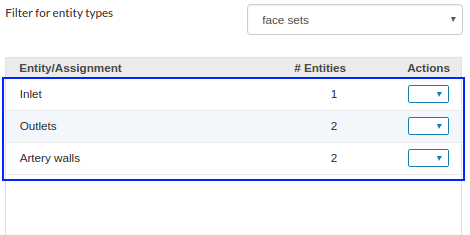
We now add a Fluid material (Blood). Select the Material item in the Navigator and click New
Specify the given properties to define the non-newtonian model for blood (for details see Documentation):
- Viscosity model: Bird-Carreau
- Viscosity at zero shear nu0 [m²/s]: 0.00005283
- Viscosity at very high shear nuInf [m²/s]: 0.0000032547
- k [s]: 3.313
- n [-]: 0.3568
- a [-]: 2
- Density [kg/m³] = 1060
Now to assign this fluid to the mesh domain, select the available domain called region0 and click save.
The boundary conditions define the flow variables at the boundary surfaces.
Click on Boundary condition and select +New.
Inlet
Select the Type as Velocity Inlet, Velocity Inlet Flow Rate and Type of flow rate as Mass flow rate
Mass flow rate [kg/s]: 0.0044
From the selection box, select the previously created Inlet set and click Save
Outlet
Add another boundary condition, select the Type as Pressure Outlet and keep the other parameters as default. (here the zero value is only a reference)
From the selection box, select the previously created ‘Outlet set’ and click Save
Artery walls
Lastly, add another boundary condition for the Artery walls.
Select the Type as Wall, velocity as No-slip and change the wall treatment to zeroGradient
From the selection box, select the previously created Artery walls topological entity set and click Save
Under the Numerics item in the Navigator, make the following changes to improve the solution accuracy.
Under Simulation Control set the parameters as follows:
- Start time value [s]: 0
- End time value [s]: 2000 (these are basically iterations for steady state analysis)
- Time step length [s]: 1
- Write control : Timestep with Write interval (simulation time steps)=2000 (to save only the final solution)
- Number of computing cores: 8
- Maximum runtime [s]: 9000
- Initialize with potential flow: false
Click on Simulation runs and create a New run.
Click the Start button at the top of the settings panel to begin the computation.
The simulation will take around 26 minutes to Finish. Once finished, the results can then be viewed.
Additional Simulations
To set up the simulations for the other 2 configurations, you can duplicate the first simulation setup by right-clicking on the Turb-Steady-BloodFlow-85pc and selecting Duplicate. Then continue by selecting the appropriate mesh (Case-2-60pc-blocked mesh or Case-1-Normal mesh) under the Domain item in the Navigator and following the previous steps.
Post-Processing
To view the results, switch to the Post processing tab.
Click on Solution fields under Run1 in the navigation tree to load the results. This will take a minute or more depending upon the internet speed. Once loaded it will be as shown in the figure below.
To visualize the internal region we will create 3 Slice filters.The parameters for each are given in the table below:
Slice Filter
To create a Slice filter, click on Run 1 and then the Add filter button. Select the Slice option.
Wait for the filter to apply. Then enter the parameters for Origin and Normal as given in the table.
Uncheck the option Show Plane and click Apply
From the fields drop down (top-left corner) select U [point-data] to view velocity magnitude.
Follow the same procedure to create the Slice 2 and Slice 3. After creating the 3 Slices, the results will look as shown below (Note: be sure to create each slice from Run 1):
To view the body walls, click again on Run 1 as shown and click the eye icon to turn it on.
From the fields drop down (top-left corner) select solid color
Then in the properties, under Representation, change Opacity to 0.3 and click Apply
Lastly, we will add a Streamlines filter to view the 3D flow.
Streamlines Filter
Click again on Run 1 (highlighted in blue) and Add filter to select Stream Tracer
Wait for the filter to apply. Then enter the parameters as below:
- Center: 0.0025, 0.001 , 0.0025
- Radius: 0.003
…and click Apply
Then from the fields drop down (top-left corner) select U [point-data] to view velocity magnitude.
Compare the results from each configuration, what observations can you make?
References
[1] The base CAD model for the Artery used in this homework session is provided by aaron from GrabCAD . It was modified and prepared for CFD analysis.

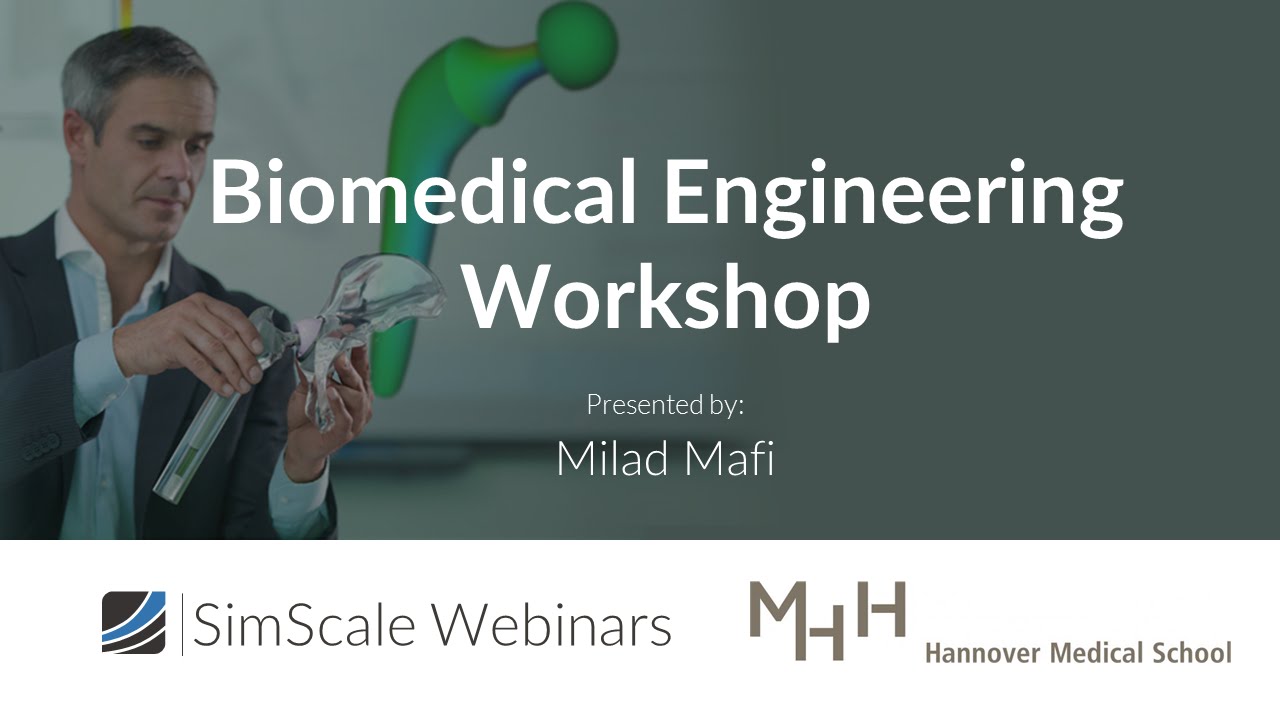
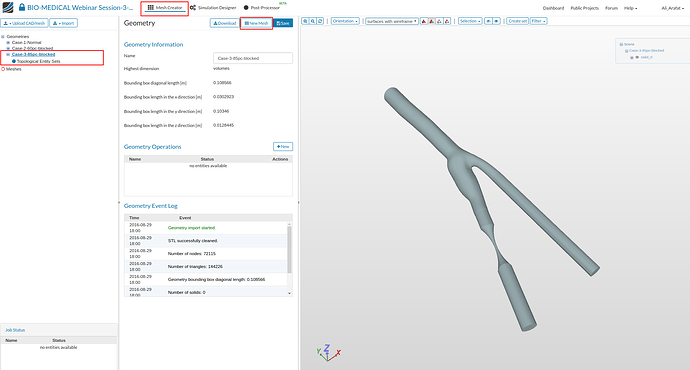
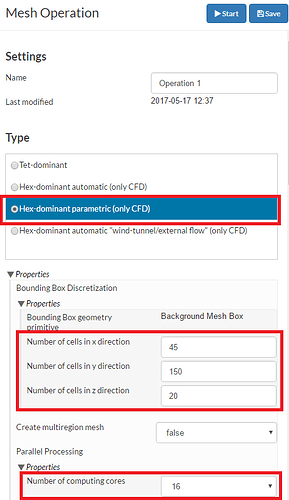
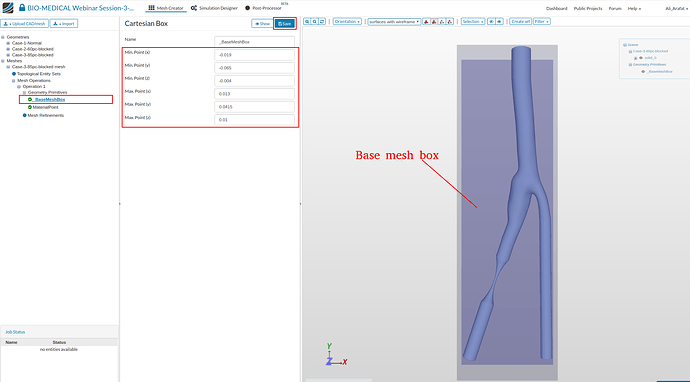
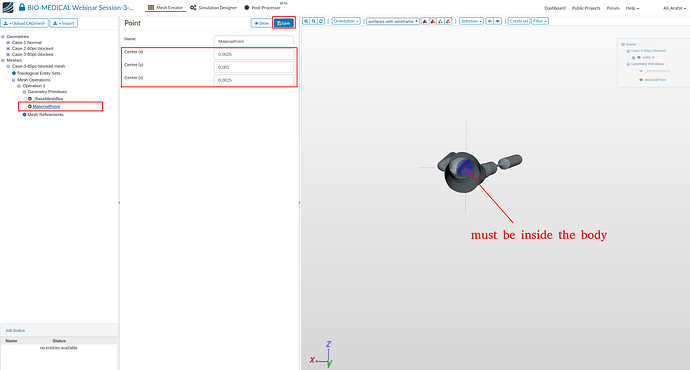
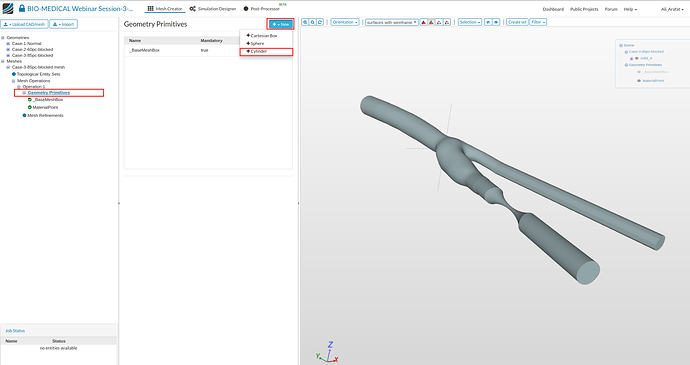
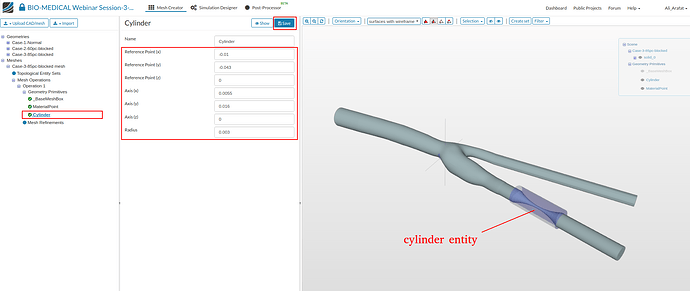
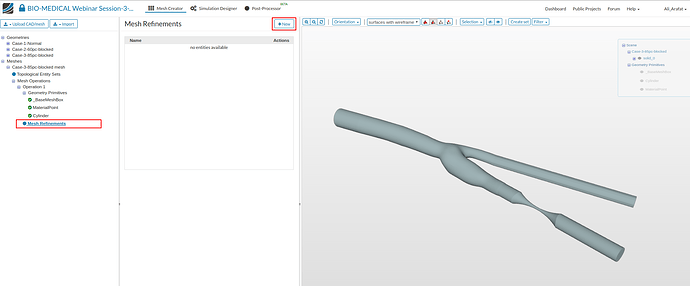
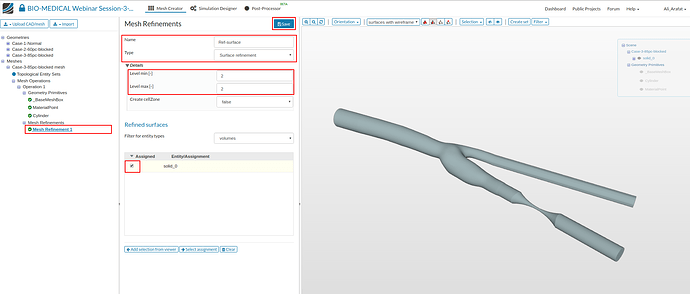

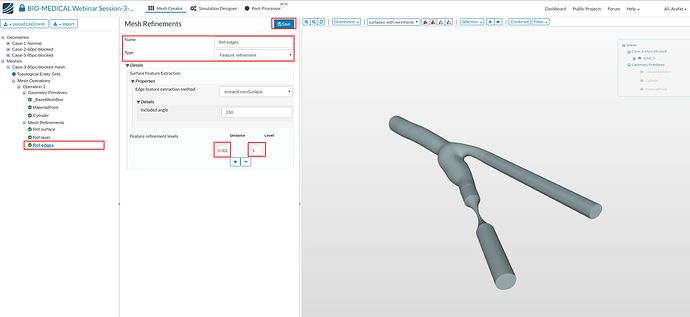
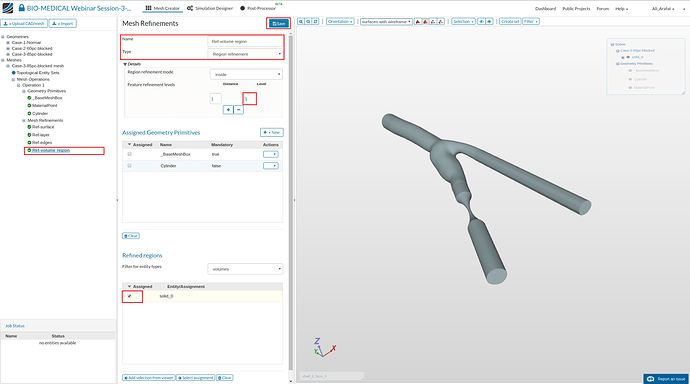
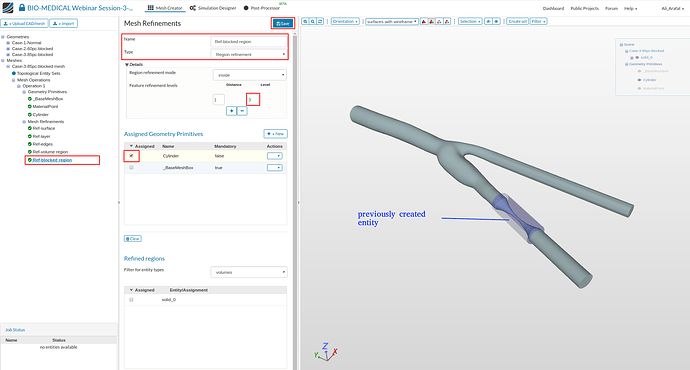
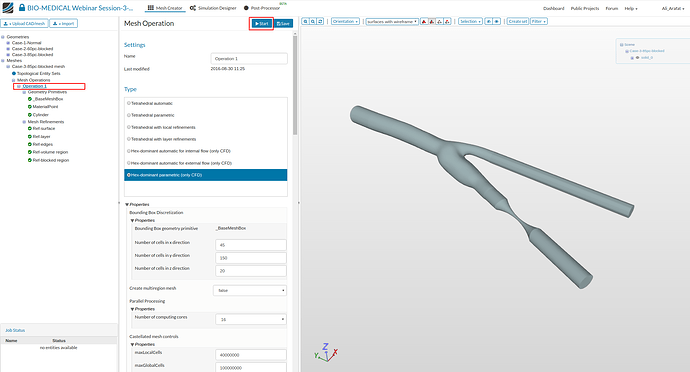
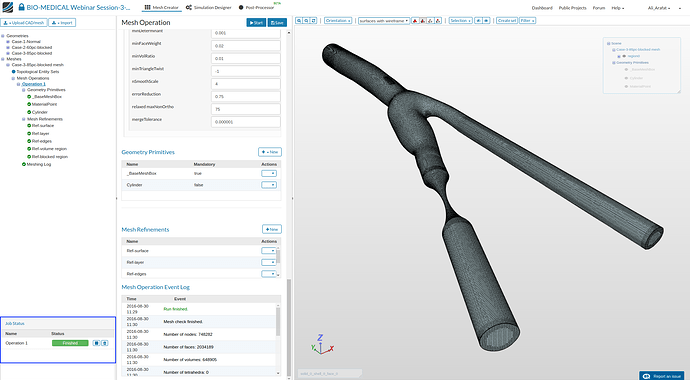
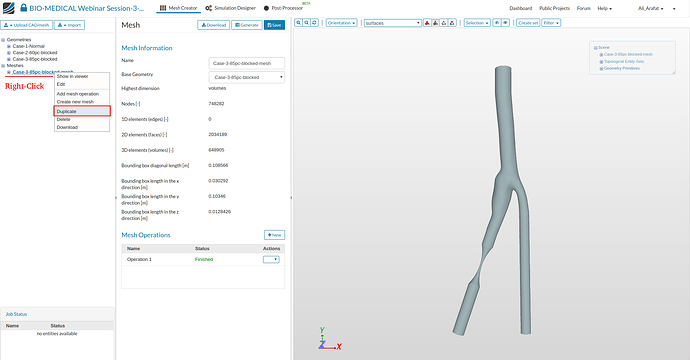
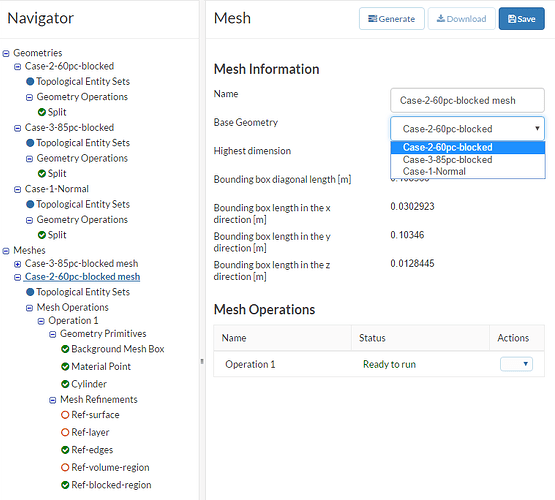
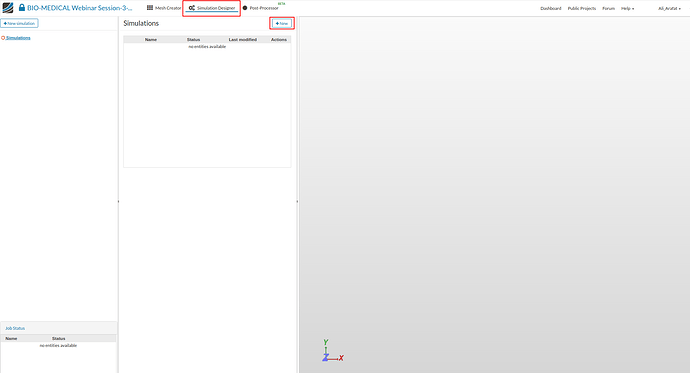
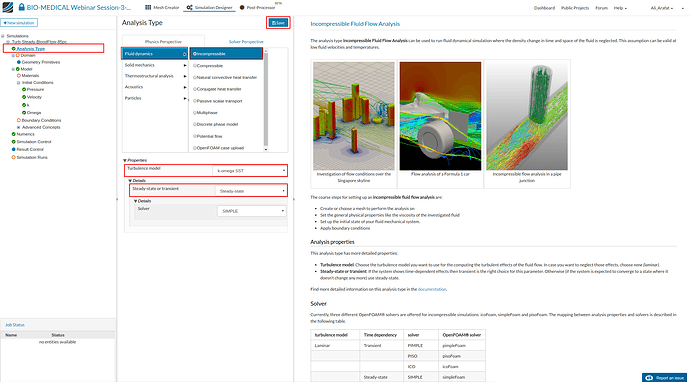
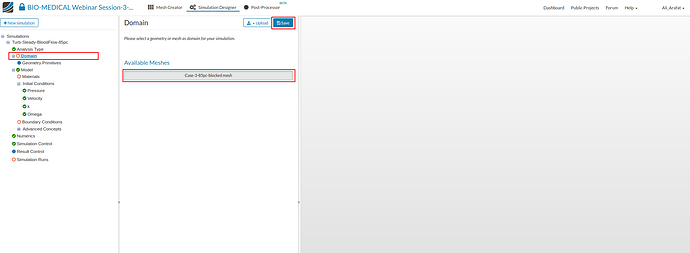
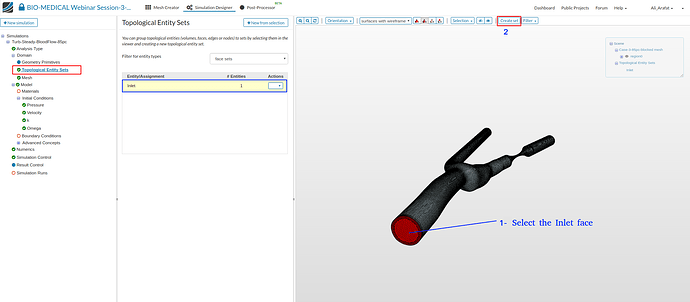

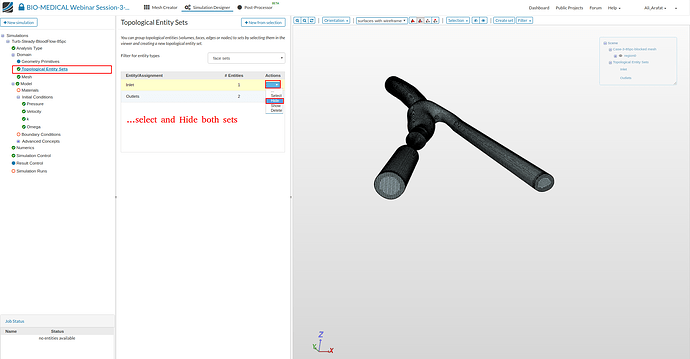
![Click on the Select button in the Toolbar [1], click Select all [2] and click Create Set [3] biomedical engineering workshop, blood flow in a carotid artery bifurcation, create topological entity sets](https://www.simscale.com/forum/uploads/default/optimized/2X/b/b86808a011d5129edd6b9a0300ceae30ca489c46_2_690x362.png)
